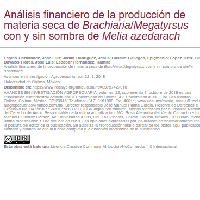Resumen
- It has been written about silvopastoral systems and its benefits, however, requires financial evaluation of the factors involved in the production process. In the present work the financial analysis of systems: 1. Silvopastoral, based on Melia azedarach and improved grasses, 2. Intensive monoculture of grasses, 3. Production of timber (M. azedarach), 4. Monoculture for grazing with 1.5 cows/ha, and 5. Monoculture for grazing with 2 cows /ha. For the systems 1 and 2 plots were established in Urochloa and Megatyrsus cultivars with and without trees and assessed the production of dry matter and growth of trees (7 years old), in a coast to mountain transition zone in a subtropical climate. Results from a ten year period shows that in the 2, 4 and 5 production systems the net present value (VAN) and consequently the internal rate of return (IRR) were negative. However, the components where the tree component has participated (sets 1 and 3), the VAN and IRR were positive and indicate that they paid the costs of investment, maintenance and therefore were profitable.
- Mucho se ha escrito sobre los sistemas silvopastoriles y sus beneficios, sin embargo, se requiere de análisis que contemplen más específicamente la evaluación financiera de todos los factores que intervienen en el proceso productivo. En el presente trabajo se realizó el análisis financiero de los sistemas: 1. Silvopastoril, con base en Melia azedarach y gramíneas mejoradas, 2. Monocultivo intensivo de gramíneas, 3. Producción de árboles maderables (M. azedarach), 4. Monocultivo en pastoreo con 1.5 vacas/ha y 5. Monocultivo en pastoreo con 2 vacas/ha. Para los sistemas 1 y 2 se establecieron parcelas de cultivares Urochloa y Megatyrsus con y sin árboles y se evaluó la producción de materia seca y crecimiento de los árboles (con edad de 7 años), en una zona de transición costa montaña con clima subcálido. Los resultados a 10 años muestran que en los sistemas de producción 2, 4 y 5 el valor actual neto (VAN) y en consecuencia la tasa interna de retorno (TIR) fueron negativos. Sin embargo, en los componentes donde participó el árbol (sistemas 1 y 3), la VAN y TIR fueron positivas e indican que pagaron los costos de inversión, mantenimiento y fueron rentables.
